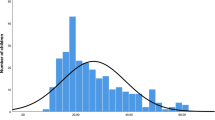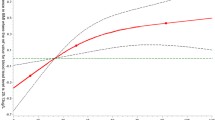Abstract
Lead (Pb) is a potent environmental toxic metal. Few studies have focused on low-level Pb exposure in children. This study evaluated the relationships of dietary patterns with low-level Pb exposure in children from Hunan province of China. A cross-sectional study was conducted in a single primary school, located in Hunan Province. In total, 425 children were recruited. Principal component analysis was used to identify dietary patterns based on dietary intake from a food frequency questionnaire (FFQ). Blood lead levels (BLLs) were measured. Multivariate regression analysis was used to investigate the associations of BLLs with dietary patterns. Three dietary patterns were identified: balanced, plant, and beverage and snack. The concentration of blood lead (median (IQR)) was 2.00 (2.00, 15.96) μg/L. Only 0.24% children’s BLLs were ≥100 µg/L and 1.18% children’s BLLs were ≥ 50 µg/L. There was a significant difference for BLLs in gender of children (p = 0.007). No significant associations were found between dietary patterns and BLLs by logistic regression analysis based on 50th percentile (P50) of blood lead. The plant pattern had a positive association with blood log-Pb (B = 0.04, 95% CI: 0.00, 0.08, p = 0.035) in group of > P50 by linear regression analysis. Systolic blood pressure (SBP) (B = 7.44, 95% CI: 2.80, 12.09, p = 0.002) and diastolic blood pressure (DBP) (B = 5.46, 95% CI: 1.53, 9.40, p = 0.007) were positively associated with blood log-Pb in group of > P50. BLLs were low among children aged 4–7 years in Hunan province of China. There was a significant difference for BLLs in gender of children. Low BLLs had no associations with dietary patterns. However, the plant pattern may become an important source of blood lead with increasing BLLs. Increasing BLLs may contribute to elevated blood pressure of children.






Similar content being viewed by others
Abbreviations
- B:
-
Unstandardized beta
- BLLs:
-
Blood lead levels
- BP:
-
Blood pressure
- BMI:
-
Body mass index
- CI:
-
Confidence interval
- CMS:
-
Clinical memory scale test
- DBP:
-
Diastolic pressure
- FFQ:
-
Food frequency questionnaire
- GFAAS:
-
Graphite furnace atomic absorption spectrometry
- IQR:
-
Inter-quartile range
- MQ:
-
Memory quotient
- OR:
-
Odds ratio
- Pb:
-
Lead
- PCA:
-
Principal component analysis
- P50:
-
50th percentile
- SBP:
-
Systolic pressure
- SD:
-
Standard deviation
References
Questionnaires of China Health and Nutrition Survey (2015) https://www.cpc.unc.edu/projects/china/data/questionnaires.
Advisory Committee on Childhood Lead Poisoning Prevention (2012) Low level lead exposure harms children; a renewed call for primary prevention, United States
Becker K, Kaus S, Krause C, Lepom P, Schulz C, Seiwert M, Seifert B (2002) German Environmental Survey 1998 (GerES III): environmental pollutants in blood of the German population. Int J Hyg Environ Health 205:297–308. https://doi.org/10.1078/1438-4639-00155
Canfield RL, Henderson CR, Cory-Slechta DA, Cox C, Jusko TA, Lanph Ea RBP (2003) Intellectual impairment in children with blood lead concentrations below 10 microg per deciliter. N Engl J Med 348:1517. https://doi.org/10.1056/NEJMoa022848
Chung HK, Park JY, Cho Y, Shin MJ (2013) Contribution of dietary patterns to blood heavy metal concentrations in Korean adults: findings from the Fifth Korea National Health and Nutrition Examination Survey 2010. Food Chem Toxicol 62:645–652. https://doi.org/10.1016/j.fct.2013.09.034
Desai G, Anzman-Frasca S, Vernarelli JA, Ravenscroft J, Yang J, Burstein G, Kordas K (2021) Examining links between diet and lead exposure in young children: 2009–2014 national health and nutrition examination survey. Acad Pediatr 21:471–479. https://doi.org/10.1016/j.acap.2020.06.009
Earl R, Burns N, Nettelbeck T, Baghurst P (2016) Low-level environmental lead exposure still negatively associated with children’s cognitive abilities. Aust J Psychol 68:98–106. https://doi.org/10.1111/ajpy.12096
Gao Y, Li X, Dong J, Cao Y, Li T, Mielke HW (2020) Snack foods and lead ingestion risks for school aged children: A comparative evaluation of potentially toxic metals and children’s exposure response of blood lead, copper and zinc levels. Chemosphere. https://doi.org/10.1016/j.chemosphere.2020.127547
Gibson JM, Fisher M, Clonch A, MacDonald JM, Cook PJ (2020) Children drinking private well water have higher blood lead than those with city water. Proc Natl Acad Sci U S A 117:16898–16907. https://doi.org/10.1073/pnas.2002729117
Heusinkveld D, Ramírez-Andreotta MD, Rodríguez-Chávez T, Sáez AE, Betterton E, Rine K (2021) Assessing children’s lead exposure in an active mining community using the integrated exposure uptake biokinetic model. Exposure and Health 13:517–533. https://doi.org/10.1007/s12403-021-00400-0
Huang Z, Li N, Hu YM (2019) Dietary patterns and their effects on postpartum weight retention of lactating women in south central China. Nutrition 67–68:110555. https://doi.org/10.1016/j.nut.2019.110555
Jin Y, Liu P, Sun J, Wang C, Min J, Zhang Y, Wang S, Wu Y (2014) Dietary exposure and risk assessment to lead of the population of Jiangsu province, China. Food Addit Contam Part A Chem Anal Control Expo Risk Assess 31:1187–1195. https://doi.org/10.1080/19440049.2014.918283
Keating EM, Fischer PR, Pettifor JM, Pfitzner M, Isichei CO, Thacher TD (2011) The effect of calcium supplementation on blood lead levels in Nigerian children. J Pediatr 159(845–850):e841. https://doi.org/10.1016/j.jpeds.2011.04.038
Kordas K, Burganowski R, Roy A, Peregalli F, Baccino V, Barcia E, Mangieri S, Ocampo V, Manay N, Martinez G, Vahter M, Queirolo EI (2018) Nutritional status and diet as predictors of children’s lead concentrations in blood and urine. Environ Int 111:43–51. https://doi.org/10.1016/j.envint.2017.11.013
Kwong WT, Friello P, Semba RD (2004) Interactions between iron deficiency and lead poisoning: epidemiology and pathogenesis. Sci Total Environ 330:21–37. https://doi.org/10.1016/j.scitotenv.2004.03.017
Lacasana M, Romieu I, Sanin LH, Palazuelos E, Hernandez-Avila M (2000) Blood lead levels and calcium intake in Mexico City children under five years of age. Int J Environ Health Res 10:331–340. https://doi.org/10.1080/0960312002001537
Lanphear BP, Hornung R, Khoury J, Yolton K, Baghurst P, Bellinger DC, Canfield RL, Dietrich KN, Bornschein R, Greene T, Rothenberg SJ, Needleman HL, Schnaas L, Wasserman G, Graziano J, Roberts R (2005) Low-level environmental lead exposure and children’s intellectual function: an international pooled analysis. Environ Health Perspect 113:894–899. https://doi.org/10.1289/ehp.7688
Li Y, Hu J, Wu W, Liu S, Li M, Yao N, Chen J, Ye L, Wang Q, Zhou Y (2016) Application of IEUBK model in lead risk assessment of children aged 61–84 months old in central China. Sci Total Environ 541:673–682. https://doi.org/10.1016/j.scitotenv.2015.09.103
Li MM, Gao ZY, Dong CY, Wu MQ, Yan J, Cao J, Ma WJ, Wang J, Gong YL, Xu J, Cai SZ, Chen JY, Xu SQ, Tong S, Tang D, Zhang J, Yan CH (2020) Contemporary blood lead levels of children aged 0–84months in China: A national cross-sectional study. Environ Int 134:105288. https://doi.org/10.1016/j.envint.2019.105288
Lim S, Ha M, Hwang SS, Son M, Kwon HJ (2015) Disparities in children’s blood lead and mercury levels according to community and individual socioeconomic positions. Int J Environ Res Public Health 12:6232–6248. https://doi.org/10.3390/ijerph120606232
Safruk AM, McGregor E, Whitfield Aslund ML, Cheung PH, Pinsent C, Jackson BJ, Hair AT, Lee M, Sigal EA (2017) The influence of lead content in drinking water, household dust, soil, and paint on blood lead levels of children in Flin Flon, Manitoba and Creighton, Saskatchewan. Sci Total Environ 593–594:202–210. https://doi.org/10.1016/j.scitotenv.2017.03.141
Sanchez C, Fente C, Barreiro R, Lopez-Racamonde O, Cepeda A, Regal P (2020) Association between breast milk mineral content and maternal adherence to healthy dietary patterns in Spain: a transversal study. Foods 9:659. https://doi.org/10.3390/foods9050659
Sanders AP, Mazzella MJ, Malin AJ, Hair GM, Busgang SA, Saland JM, Curtin P (2019) Combined exposure to lead, cadmium, mercury, and arsenic and kidney health in adolescents age 12–19 in NHANES 2009–2014. Environ Int 131:104993. https://doi.org/10.1016/j.envint.2019.104993
Schell LM, Denham M, Stark AD, Ravenscroft J, Parsons P, Schulte E (2004) Relationship between blood lead concentration and dietary intakes of infants from 3 to 12 months of age. Environ Res 96:264–273. https://doi.org/10.1016/j.envres.2004.02.008
Shah-Kulkarni S, Ha M, Kim BM, Kim E, Hong YC, Park H, Kim Y, Kim BN, Chang N, Oh SY, Kim YJ, Lee B, Ha EH (2016) Neurodevelopment in early childhood affected by prenatal lead exposure and iron intake. Medicine (baltimore) 95:e2508. https://doi.org/10.1097/MD.0000000000002508
Shi Z (2020) Cadmium intake, dietary patterns and hyperuricemia among adults in China. Exposure and Health 13:219–227. https://doi.org/10.1007/s12403-020-00375-4
Shi Z, El-Obeid T, Li M, Xu X, Liu J (2019) Iron-related dietary pattern increases the risk of poor cognition. Nutr J 18:48. https://doi.org/10.1186/s12937-019-0476-9
Skerfving S, Lofmark L, Lundh T, Mikoczy Z, Stromberg U (2015) Late effects of low blood lead concentrations in children on school performance and cognitive functions. Neurotoxicology 49:114–120. https://doi.org/10.1016/j.neuro.2015.05.009
Wang S, Zhang J (2006) Blood lead levels in children, China. Environ Res 101:412–418. https://doi.org/10.1016/j.envres.2005.11.007
Wang X, Ding N, Tucker KL, Weisskopf MG, Sparrow D, Hu H, Park SK (2017) A western diet pattern is associated with higher concentrations of blood and bone lead among middle-aged and elderly men. J Nutr 147:1374–1383. https://doi.org/10.3945/jn.117.249060
Warembourg C, Maitre L, Tamayo-Uria I, Fossati S, Roumeliotaki T, Aasvang GM, Andrusaityte S, Casas M, Cequier E, Chatzi L, Dedele A, Gonzalez JR, Grazuleviciene R, Haug LS, Hernandez-Ferrer C, Heude B, Karachaliou M, Krog NH, McEachan R, Nieuwenhuijsen M, Petraviciene I, Quentin J, Robinson O, Sakhi AK, Slama R, Thomsen C, Urquiza J, Vafeiadi M, West J, Wright J, Vrijheid M, Basagana X (2019) Early-life environmental exposures and blood pressure in children. J Am Coll Cardiol 74:1317–1328. https://doi.org/10.1016/j.jacc.2019.06.069
Woo MK, Young ES, Mostofa MG, Afroz S, Sharif Ibne Hasan MO, Quamruzzaman Q, Bellinger DC, Christiani DC, Mazumdar M (2018) Lead in air in Bangladesh: exposure in a rural community with elevated blood lead concentrations among young children. Int J Environ Res Public Health 15:1947
World Health Organization (2010) Childhood Lead Poisoning. Switzerland.
Xu R, Zhou Y, Li Y, Zhang X, Chen Z, Wan Y, Gao X (2019) Snack cost and percentage of body fat in Chinese children and adolescents: a longitudinal study. Eur J Nutr 58:2079–2086. https://doi.org/10.1007/s00394-018-1769-z
Xu SL, Wu Z, Sun C (1996) Handbook of Clinical Memory Scale Test. Institute of Psychology of Chinese Academy of Science, Beijing.
Yang Y, Shu X, Wang Z, Lai J, Zeng G (2017) Chinese dietary guidelines for pre-school children (2016). Chinese J Child Health Care 25:325–327. https://doi.org/10.11852/zgetbjzz2017-25-04-01
Zachariah JP, Wang Y, Penny DJ, Baranowski T (2018) Relation between lead exposure and trends in blood pressure in children. Am J Cardiol 122:1890–1895. https://doi.org/10.1016/j.amjcard.2018.08.033
Zhang Y, O’Connor D, Xu W, Hou D (2020) Blood lead levels among Chinese children: The shifting influence of industry, traffic, and e-waste over three decades. Environ Int. https://doi.org/10.1016/j.envint.2019.105379
Zimmermann MB, Muthayya S, Moretti D, Kurpad A, Hurrell RF (2006) Iron fortification reduces blood lead levels in children in Bangalore, India. Pediatrics 117:2014–2021. https://doi.org/10.1542/peds.2005-2440
Acknowledgements
We thank the participants for their assistance and support. We acknowledge support from the National Nature Science Foundation of China (21775040, 21775041, 21575040), the Aid Program for S&T innovation research team in higher education institution, the construction program of key disciplines of Hunan Province (2015JC1001).
Funding
Self-funded.
Author information
Authors and Affiliations
Contributions
ZH, BC, XC, MC, and YH performed the research. ZH, BC, and YH designed the research study. BC and YH contributed essential reagents or tools. ZH, MC, and ML analyzed the data. ZH wrote the paper.
Corresponding authors
Ethics declarations
Conflict of interest
No conflict of interest exists in the submission of this manuscript, and manuscript is approved by all authors for publication.
Ethical Approval
All participants signed the informed consent form, and the study procedure was approved by the ethics committee of Hunan Center for Disease Control and Prevention.
Additional information
Publisher's Note
Springer Nature remains neutral with regard to jurisdictional claims in published maps and institutional affiliations.
Supplementary Information
Below is the link to the electronic supplementary material.
Rights and permissions
About this article
Cite this article
Huang, Z., Yin, Xc., Chen, M. et al. Relationships Between Dietary Patterns and Low-Level Lead Exposure Among Children from Hunan Province of China. Expo Health 14, 531–541 (2022). https://doi.org/10.1007/s12403-021-00432-6
Received:
Revised:
Accepted:
Published:
Issue Date:
DOI: https://doi.org/10.1007/s12403-021-00432-6




